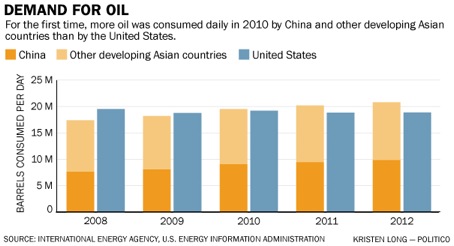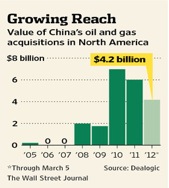According to the Energy Information Administration (EIA), China became the world’s fourth largest oil producer in 2010, beating out Iran, who formerly held that spot. Only Saudi Arabia, Russia, and the United States produced more oil than China in 2010. China’s demand for oil is also growing. In 2010, China and other developing Asian nations consumed more oil than the United States. According to the International Energy Agency (IEA), their oil demand rose from 17.4 million barrels a day in 2008 to 20.8 million barrels a day. That contrasts with an almost 10 percent drop in petroleum liquids demand in the United States between 2005, when it peaked, and 2011.[i] According to IEA and EIA projections, China’s energy consumption, which has already surpassed that of the United States, is expected to be about 70 percent greater than U.S. energy consumption by 2035.[ii]
China’s Oil Grab
China and India are taking actions to insulate themselves from oil shortages and high prices that include subsidizing their oil industry, providing loans to oil rich countries in exchange for oil in the future, and investing in foreign oil resources. According to the IEA, China and India provided a combined $24 billion in oil industry subsidies in 2010, which dwarfs the mere $4 billion in U.S. oil industry tax breaks that President Obama is seeking to end. Elimination of the tax breaks for the U.S. oil industry could decrease future oil exploration, development and production; increase gasoline prices; and increase the nation’s dependence on foreign oil while increasing tax collections by just $4 billion.
Other actions China has taken to ensure adequate oil supplies are:
- China is adding 764,000 barrels per day of new crude refining capacity in 2012, bringing total refining capacity to 11.6 million barrels per day. In contrast, the United States is removing refining capacity due to new layers of onerous regulations, lower demand for liquid fuels, and lower refinery margins, thus making it difficult for refineries to earn a profit.[iii]
- In December 2008, China began test operation of its first coal-to-liquids plant, which is already making a profit, and plans to reach 1 million tons of annual capacity. Coal-to-liquids technology is not allowed for military use in the United States due to the Energy Independence and Security Act that does not permit the military to use any fuel that releases more carbon dioxide than traditional petroleum.[iv] China already consumes more than three times as much coal as the United States and that is expected to grow rapidly.
- Since 2010, Chinese companies invested more than $17 billion into oil and gas deals in the United States and Canada. In 2009, China National Petroleum Corp. bought 60 percent stakes in two oil-sands projects for about $1.9 billion. The following year, Sinopec committed $4.65 billion for a 9 percent stake in Alberta’s Syncrude oil-sands project. Last year, Cnooc agreed to pay $2.1 billion for OPTI Canada Inc.[v] In contrast, environmentalists want to ban the use of oil sands in the United States because of its higher emissions even though those emissions are only slightly higher and will not stop its production and consumption elsewhere.
- PetroChina, owned 86 percent by the Chinese government, produced 2.4 million barrels of oil a day last year, surpassing Exxon by 100,000 barrels of oil produced a day. PetroChina’s output increased 3.3 percent in 2011 while Exxon’s fell 5 percent. PetroChina outspent Western companies, acquiring petroleum reserves in Iraq, Australia, Africa, Qatar and Canada. Since 2010, its acquisitions have totaled $7 billion, about twice as much as Exxon. According to the IEA, total acquisitions by Chinese energy firms increased from less than $2 billion between 2002 and 2003 to nearly $48 billion in 2009 and 2010.[vi]
- China is purported to have offered to pay for construction of a pipeline to bring Canadian oil sands to Canada’s Pacific Coast, an opportunity that became available when President Obama rejected a decision on the construction of the Keystone XL pipeline between Alberta’s oil fields and the Gulf Coast of the United States until after the election.[vii]
Conclusion
IHS Global Insight, a forecasting firm, expects car demand in China to reach 30 million vehicles a year by 2020, twice the size of the current U.S. market.[viii] Expecting that growth, China is taking steps now to ensure adequate oil supplies by taking advantage of opportunities to obtain oil worldwide. It is also pursuing oil production from its aging fields. China and India subsidize their oil and gas industry to a level 6 times greater than that of the United States. Rather than pursuing increased sources of supply for the future and helping its oil and gas industry as China and India are doing, the White House wants to use the strategic petroleum reserve as it did last year and end tax breaks for U.S. oil companies.
[i] Energy Information Administration, Monthly Energy Review, http://www.eia.gov/totalenergy/data/monthly/pdf/sec3_3.pdf
[ii] Politico, China’s surging oil demand could pump up prices, March 6, 2012, http://www.politico.com/news/stories/0312/73689.html
[iii] Reuters, China oil demand growth seen easing in 2012, February 9, 2012, http://www.reuters.com/article/2012/02/09/china-oil-cnpc-idUSL4E8D914I20120209
[iv] Institute for Energy Research, China’s Coal to Liquids Program Not Allowed In the United States, June 28, 2011, https://www.instituteforenergyresearch.org/2011/06/28/china%E2%80%99s-coal-to-liquids-program-not-allowed-in-the-united-states/
[v] Wall Street Journal, China Foothold in U.S. Energy, March 6, 2012, http://online.wsj.com/article/SB10001424052970204883304577223083067806776.html?mod=WSJ_hp_LEFTTopStories
[vi] Washington Post, PetroChina produced more oil than industry giant ExxonMobil in 2011, March 29, 2012, http://www.washingtonpost.com/business/industries/petrochina-produced-more-oil-than-industry-giant-exxon-mobil-in-2011/2012/03/29/gIQATc3IiS_story.html
[vii] New York Times, The Politics of Keystone, February 10, 2012, http://www.nytimes.com/2012/02/11/opinion/nocera-the-politics-of-keystone-take-2.html?_r=2&nl=todaysheadlines&emc=tha212
[viii] Wall Street Journal, Why China Can’t Avoid Oil Addiction, March 29, 2012, http://blogs.wsj.com/chinarealtime/2012/03/29/why-china-cant-avoid-oil-addiction/





